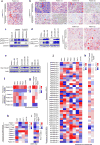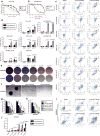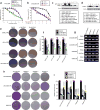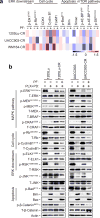PAK signalling drives acquired drug resistance to MAPK inhibitors in BRAF-mutant melanomas
- PMID: 28953887
- PMCID: PMC5891348
- DOI: 10.1038/nature24040
PAK signalling drives acquired drug resistance to MAPK inhibitors in BRAF-mutant melanomas
Erratum in
-
Author Correction: PAK signalling drives acquired drug resistance to MAPK inhibitors in BRAF-mutant melanomas.Nature. 2019 Jan;565(7738):E4. doi: 10.1038/s41586-018-0814-7. Nature. 2019. PMID: 30532003
Abstract
Targeted BRAF inhibition (BRAFi) and combined BRAF and MEK inhibition (BRAFi and MEKi) therapies have markedly improved the clinical outcomes of patients with metastatic melanoma. Unfortunately, the efficacy of these treatments is often countered by the acquisition of drug resistance. Here we investigated the molecular mechanisms that underlie acquired resistance to BRAFi and to the combined therapy. Consistent with previous studies, we show that resistance to BRAFi is mediated by ERK pathway reactivation. Resistance to the combined therapy, however, is mediated by mechanisms independent of reactivation of ERK in many resistant cell lines and clinical samples. p21-activated kinases (PAKs) become activated in cells with acquired drug resistance and have a pivotal role in mediating resistance. Our screening, using a reverse-phase protein array, revealed distinct mechanisms by which PAKs mediate resistance to BRAFi and the combined therapy. In BRAFi-resistant cells, PAKs phosphorylate CRAF and MEK to reactivate ERK. In cells that are resistant to the combined therapy, PAKs regulate JNK and β-catenin phosphorylation and mTOR pathway activation, and inhibit apoptosis, thereby bypassing ERK. Together, our results provide insights into the molecular mechanisms underlying acquired drug resistance to current targeted therapies, and may help to direct novel drug development efforts to overcome acquired drug resistance.
Conflict of interest statement
The authors declare no conflict of interests.
Figures












Similar articles
-
Targeting mTOR signaling overcomes acquired resistance to combined BRAF and MEK inhibition in BRAF-mutant melanoma.Oncogene. 2021 Sep;40(37):5590-5599. doi: 10.1038/s41388-021-01911-5. Epub 2021 Jul 24. Oncogene. 2021. PMID: 34304249 Free PMC article.
-
COT drives resistance to RAF inhibition through MAP kinase pathway reactivation.Nature. 2010 Dec 16;468(7326):968-72. doi: 10.1038/nature09627. Epub 2010 Nov 24. Nature. 2010. PMID: 21107320 Free PMC article.
-
ER Translocation of the MAPK Pathway Drives Therapy Resistance in BRAF-Mutant Melanoma.Cancer Discov. 2019 Mar;9(3):396-415. doi: 10.1158/2159-8290.CD-18-0348. Epub 2018 Dec 18. Cancer Discov. 2019. PMID: 30563872 Free PMC article.
-
Mutant BRAF melanomas--dependence and resistance.Cancer Cell. 2011 Jan 18;19(1):11-5. doi: 10.1016/j.ccr.2011.01.008. Cancer Cell. 2011. PMID: 21251612 Review.
-
Resistance to combination BRAF and MEK inhibition in metastatic melanoma: Where to next?Eur J Cancer. 2016 Jul;62:76-85. doi: 10.1016/j.ejca.2016.04.005. Epub 2016 May 24. Eur J Cancer. 2016. PMID: 27232329 Review.
Cited by
-
A Comprehensive Review on MAPK: A Promising Therapeutic Target in Cancer.Cancers (Basel). 2019 Oct 22;11(10):1618. doi: 10.3390/cancers11101618. Cancers (Basel). 2019. PMID: 31652660 Free PMC article. Review.
-
Design, Synthesis, In Vitro and In Vivo Characterization of CDC42 GTPase Interaction Inhibitors for the Treatment of Cancer.J Med Chem. 2023 Apr 27;66(8):5981-6001. doi: 10.1021/acs.jmedchem.3c00276. Epub 2023 Apr 7. J Med Chem. 2023. PMID: 37026468 Free PMC article.
-
Myosin II Reactivation and Cytoskeletal Remodeling as a Hallmark and a Vulnerability in Melanoma Therapy Resistance.Cancer Cell. 2020 Jan 13;37(1):85-103.e9. doi: 10.1016/j.ccell.2019.12.003. Cancer Cell. 2020. PMID: 31935375 Free PMC article.
-
Targeting TBK1 to overcome resistance to cancer immunotherapy.Nature. 2023 Mar;615(7950):158-167. doi: 10.1038/s41586-023-05704-6. Epub 2023 Jan 12. Nature. 2023. PMID: 36634707 Free PMC article.
-
Recognition of physiological phosphorylation sites by p21-activated kinase 4.J Struct Biol. 2020 Sep 1;211(3):107553. doi: 10.1016/j.jsb.2020.107553. Epub 2020 Jun 23. J Struct Biol. 2020. PMID: 32585314 Free PMC article.
References
-
- Boussemart L, et al. eIF4F is a nexus of resistance to anti-BRAF and anti-MEK cancer therapies. Nature. 2014;513:105–109. - PubMed
-
- Larkin J, et al. Combined vemurafenib and cobimetinib in BRAF-mutated melanoma. N. Engl. J. Med. 2014;371:1867–1876. - PubMed
-
- Long GV, et al. Increased MAPK reactivation in early resistance to dabrafenib/trametinib combination therapy of BRAF-mutant metastatic melanoma. Nat. Commun. 2014;5:5694. - PubMed
Publication types
MeSH terms
Substances
Grants and funding
LinkOut - more resources
Full Text Sources
Other Literature Sources
Medical
Molecular Biology Databases
Research Materials
Miscellaneous

